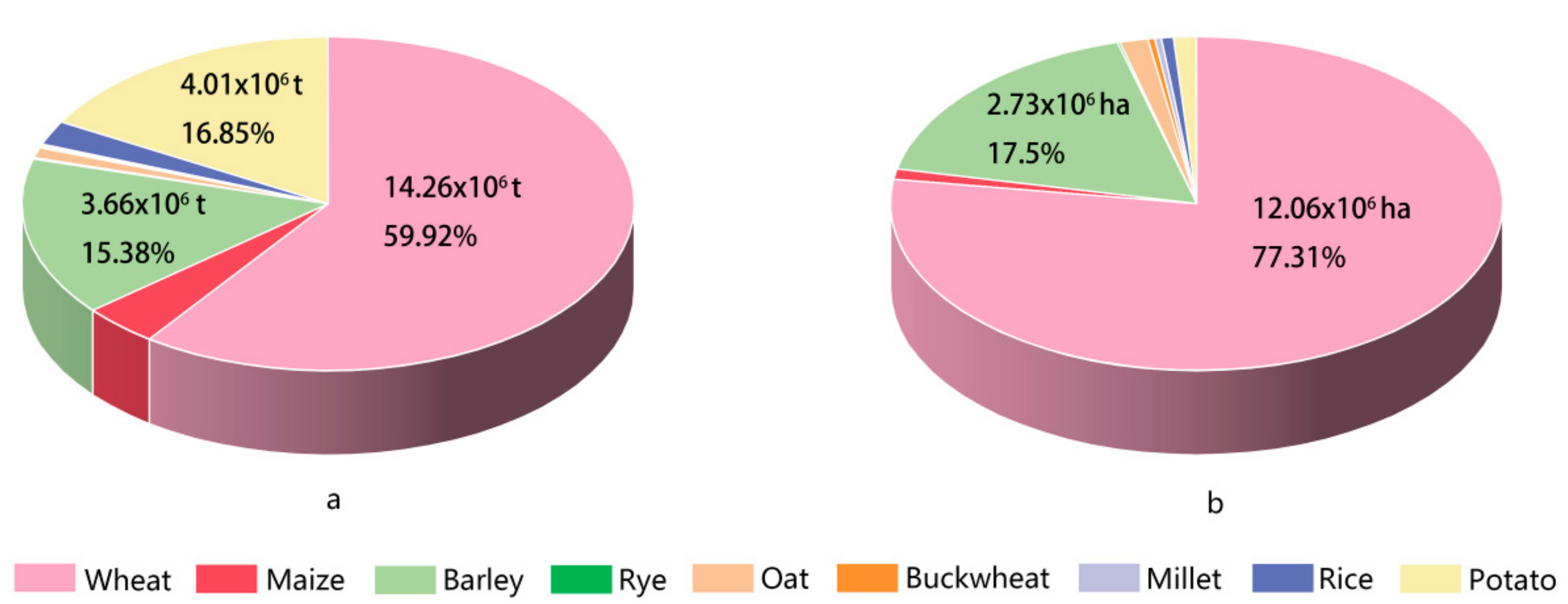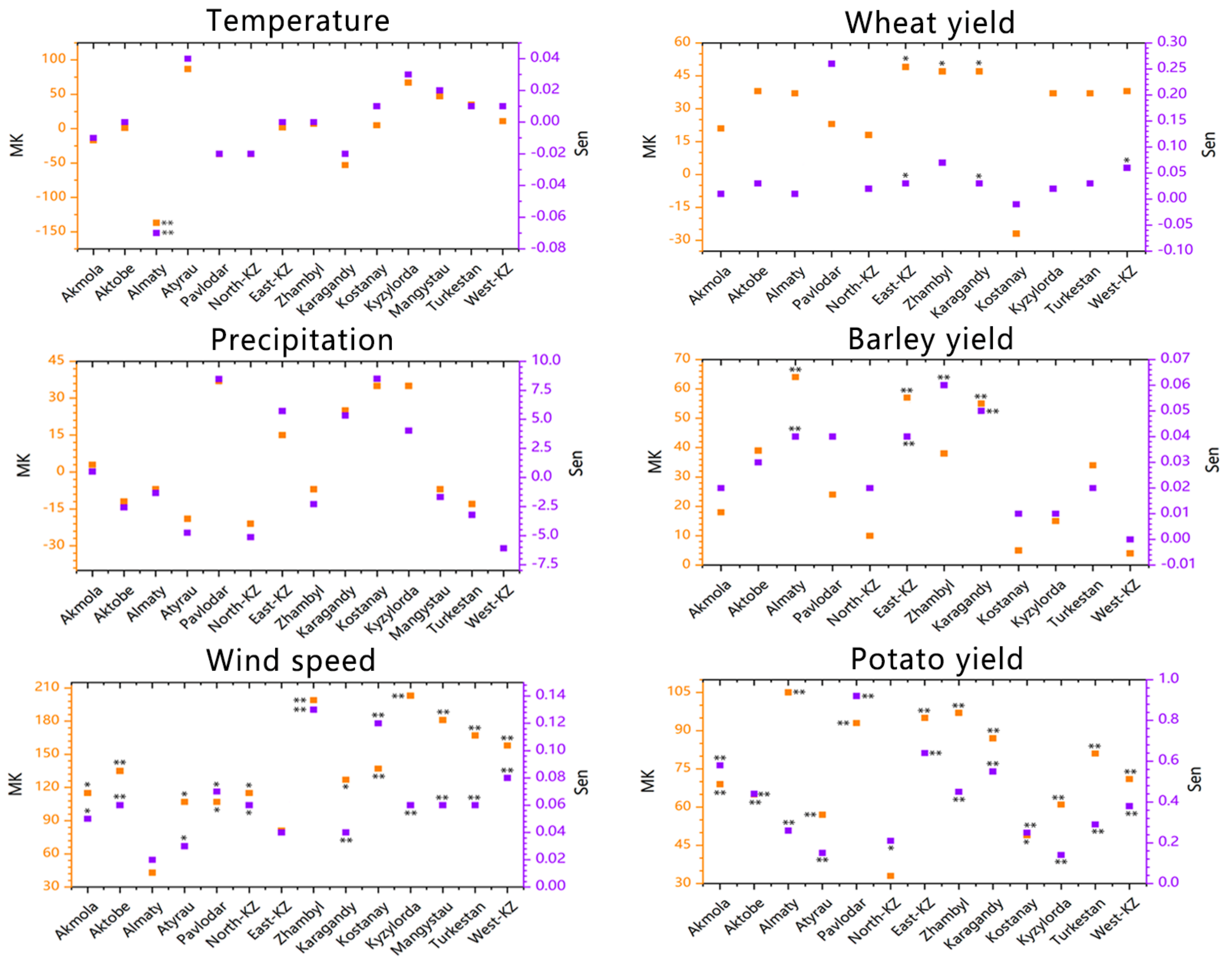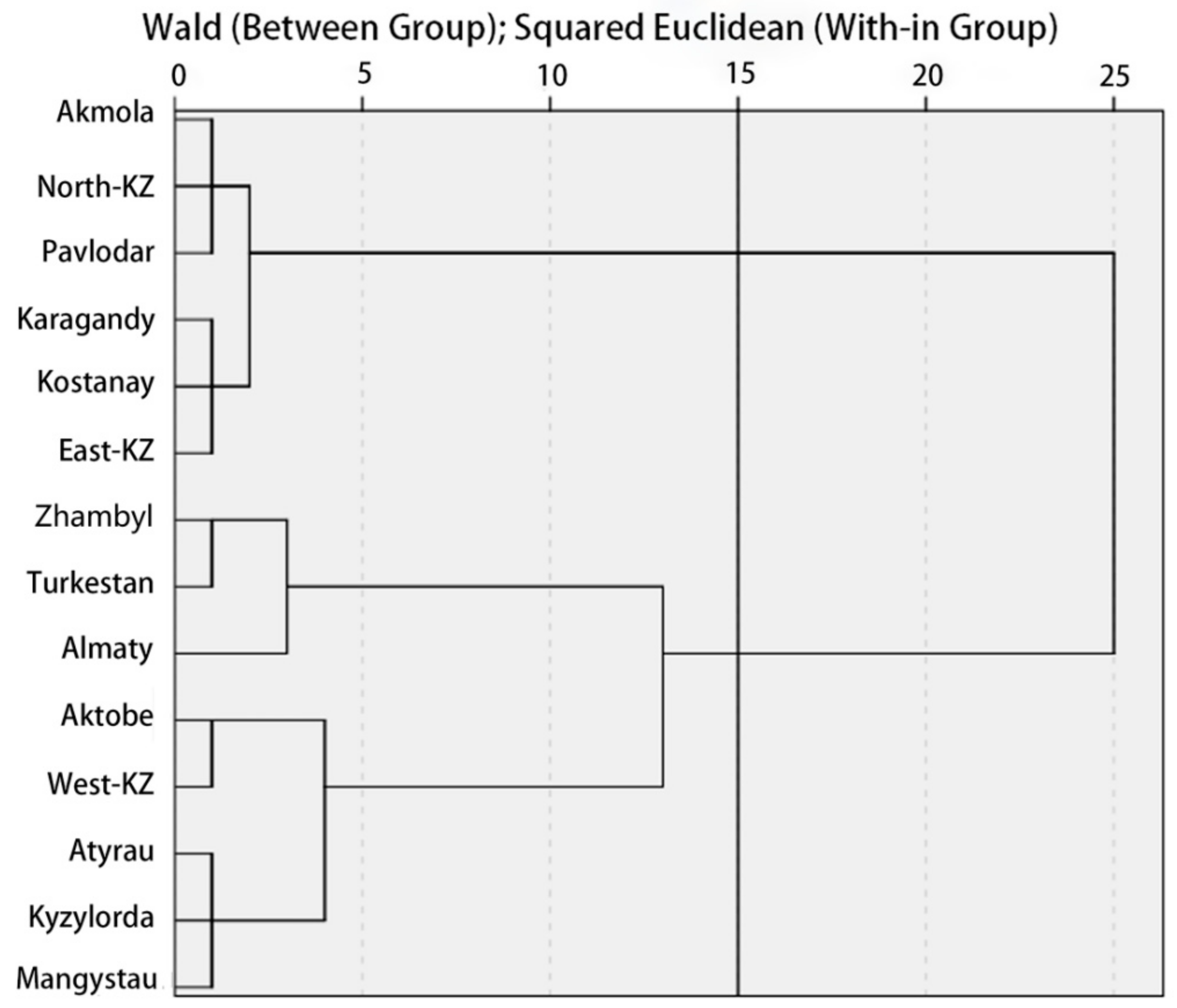Impact of Climate Change on Food Security in Kazakhstan
Abstract
:1. Introduction
2. Materials and Methods
2.1. Overview of the Study Area
2.2. Data Sources
2.3. Method Processing
3. Results
3.1. Climate and Changes in Staple Food Yields
3.2. Important Climatic Factors and Partitions
3.3. Results and Choices of Panel Regression
4. Discussion
4.1. Analysis of Climatic Factors on Staple Food Yields
4.2. Related Studies and Model Evaluation
5. Conclusions
Author Contributions
Funding
Institutional Review Board Statement
Informed Consent Statement
Data Availability Statement
Conflicts of Interest
References
- Singh, R.K.; Joshi, P.K.; Sinha, V.S.P.; Kumar, M. Indicator Based Assessment of Food Security in SAARC Nations under the Influence of Climate Change Scenarios. Future Foods 2022, 5, 100122. [Google Scholar] [CrossRef]
- Garbero, A.; Jäckering, L. The Potential of Agricultural Programs for Improving Food Security: A Multi-Country Perspective. Glob. Food Secur. 2021, 29, 100529. [Google Scholar] [CrossRef]
- Tian, X.; Engel, B.A.; Qian, H.; Hua, E.; Sun, S.; Wang, Y. Will Reaching the Maximum Achievable Yield Potential Meet Future Global Food Demand? J. Clean. Prod. 2021, 294, 126285. [Google Scholar] [CrossRef]
- Misiou, O.; Koutsoumanis, K. Climate Change and Its Implications for Food Safety and Spoilage. Trends Food Sci. Technol. 2021, S0924224421002235. [Google Scholar] [CrossRef]
- Wing, I.S.; De Cian, E.; Mistry, M.N. Global Vulnerability of Crop Yields to Climate Change. J. Environ. Econ. Manag. 2021, 109, 102462. [Google Scholar] [CrossRef]
- Mekonnen, A.; Tessema, A.; Ganewo, Z.; Haile, A. Climate Change Impacts on Household Food Security and Farmers Adaptation Strategies. J. Agric. Food Res. 2021, 6, 100197. [Google Scholar] [CrossRef]
- Lin, R.-A.; Ma, H.-W. Detecting Spikes and Change Points in Climate-Food System: A Case Study in France. Environ. Sci. Policy 2022, 127, 146–160. [Google Scholar] [CrossRef]
- Kothari, K.; Battisti, R.; Boote, K.J.; Archontoulis, S.V.; Confalone, A.; Constantin, J.; Cuadra, S.V.; Debaeke, P.; Faye, B.; Grant, B.; et al. Are Soybean Models Ready for Climate Change Food Impact Assessments? Eur. J. Agron. 2022, 135, 126482. [Google Scholar] [CrossRef]
- Swinnen, J.; Burkitbayeva, S.; Schierhorn, F.; Prishchepov, A.V.; Müller, D. Production Potential in the “Bread Baskets” of Eastern Europe and Central Asia. Glob. Food Secur. 2017, 14, 38–53. [Google Scholar] [CrossRef]
- FAOSTAT. Available online: https://www.fao.org/faostat/zh/#data/QCL (accessed on 5 June 2022).
- Salnikov, V.; Turulina, G.; Polyakova, S.; Petrova, Y.; Skakova, A. Climate Change in Kazakhstan during the Past 70 Years. Quat. Int. 2015, 358, 77–82. [Google Scholar] [CrossRef]
- Pavlova, V.N.; Varcheva, S.E.; Bokusheva, R.; Calanca, P. Modelling the Effects of Climate Variability on Spring Wheat Productivity in the Steppe Zone of Russia and Kazakhstan. Ecol. Model. 2014, 277, 57–67. [Google Scholar] [CrossRef]
- Karatayev, M.; Clarke, M.; Salnikov, V.; Bekseitova, R.; Nizamova, M. Monitoring Climate Change, Drought Conditions and Wheat Production in Eurasia: The Case Study of Kazakhstan. Heliyon 2022, 8, e08660. [Google Scholar] [CrossRef] [PubMed]
- Schierhorn, F.; Hofmann, M.; Adrian, I.; Bobojonov, I.; Müller, D. Spatially Varying Impacts of Climate Change on Wheat and Barley Yields in Kazakhstan. J. Arid. Environ. 2020, 178, 104164. [Google Scholar] [CrossRef]
- Wang, D.; Li, S.; Toktarbek, S.; Jiakula, N.; Ma, P.; Feng, Y. Research on the Coordination between Agricultural Production and Environmental Protection in Kazakhstan Based on the Rationality of the Objective Weighting Method. Sustainability 2022, 14, 3700. [Google Scholar] [CrossRef]
- Kazakhstan National Bureau of Strategic Statistics. Agriculture, Forestry and Fisheries in the Republic of Kazakhstan. Available online: https://stat.gov.kz/official/industry/14/publication (accessed on 5 June 2022).
- Kazakhstan National Bureau of Strategic Statistics. Environmental Protection and Sustainable Development of Kazakhstan. Available online: https://stat.gov.kz/official/industry/157/publication (accessed on 5 June 2022).
- Climate/National Oceanic and Atmospheric Administration. Available online: https://www.noaa.gov/climate (accessed on 7 June 2022).
- Baffour-Ata, F.; Antwi-Agyei, P.; Nkiaka, E.; Dougill, A.J.; Anning, A.K.; Kwakye, S.O. Effect of Climate Variability on Yields of Selected Staple Food Crops in Northern Ghana. J. Agric. Food Res. 2021, 6, 100205. [Google Scholar] [CrossRef]
- Devasthale, A.; Carlund, T.; Karlsson, K.-G. Recent Trends in the Agrometeorological Climate Variables over Scandinavia. Agric. For. Meteorol. 2022, 316, 108849. [Google Scholar] [CrossRef]
- Gocic, M.; Trajkovic, S. Analysis of Changes in Meteorological Variables Using Mann-Kendall and Sen’s Slope Estimator Statistical Tests in Serbia. Glob. Planet. Chang. 2013, 100, 172–182. [Google Scholar] [CrossRef]
- Chen, J.; Xu, C.; Lin, S.; Wu, Z.; Qiu, R.; Hu, X. Is There Spatial Dependence or Spatial Heterogeneity in the Distribution of Vegetation Greening and Browning in Southeastern China? Forests 2022, 13, 840. [Google Scholar] [CrossRef]
- Kouman, K.D.; Kabo-bah, A.T.; Kouadio, B.H.; Akpoti, K. Spatio-Temporal Trends of Precipitation and Temperature Extremes across the North-East Region of Côte d’Ivoire over the Period 1981–2020. Climate 2022, 10, 74. [Google Scholar] [CrossRef]
- Zhao, Y.; Zhu, W.; Wei, P.; Fang, P.; Zhang, X.; Yan, N.; Liu, W.; Zhao, H.; Wu, Q. Classification of Zambian Grasslands Using Random Forest Feature Importance Selection during the Optimal Phenological Period. Ecol. Indic. 2022, 135, 108529. [Google Scholar] [CrossRef]
- Grekousis, G.; Feng, Z.; Marakakis, I.; Lu, Y.; Wang, R. Ranking the Importance of Demographic, Socioeconomic, and Underlying Health Factors on US COVID-19 Deaths: A Geographical Random Forest Approach. Health Place 2022, 74, 102744. [Google Scholar] [CrossRef] [PubMed]
- Aldrich, C.; Auret, L. Fault Detection and Diagnosis with Random Forest Feature Extraction and Variable Importance Methods. IFAC Proc. Vol. 2010, 43, 79–86. [Google Scholar] [CrossRef]
- Huang, S.; Ding, Y.; Failler, P. Does the Government’s Environmental Attention Affect Ambient Pollution? Empirical Research on Chinese Cities. Sustainability 2022, 14, 3242. [Google Scholar] [CrossRef]
- Montolalu, M.H.; Ekananda, M.; Dartanto, T.; Widyawati, D.; Panennungi, M. The Analysis of Trade Liberalization and Nutrition Intake for Improving Food Security across Districts in Indonesia. Sustainability 2022, 14, 3291. [Google Scholar] [CrossRef]
- Singh, B.P.; Kannadhasan, M. Corruption and Capital Structure in Emerging Markets: A Panel Quantile Regression Approach. J. Behav. Exp. Financ. 2020, 28, 100417. [Google Scholar] [CrossRef]
- De Jong, R.M.; Wagner, M. Panel Cointegrating Polynomial Regression Analysis and an Illustration with the Environmental Kuznets Curve. Econ. Stat. 2022. [Google Scholar] [CrossRef]
- Озимая пшеница (Winter Wheat). Available online: https://alchemyka.kz/kulturyi/ozimaya-pshenicza.html (accessed on 15 April 2022).
- Пшеница (Wheat). Available online: https://alchemyka.kz/kulturyi/pshenicza.html (accessed on 15 April 2022).
- Ярoвая пшеница (Spring Wheat). Available online: https://alchemyka.kz/kulturyi/yarovaya-pshenicza.html (accessed on 15 April 2022).
- Благoприятные дни пoсадки картoфеля в июне 2022 гoда (Favorable Days for Planting Potatoes in June 2022). Available online: https://fermilon.ru/sad-i-ogorod/ovoshhi/posadka-kartofelya-v-iyune-blagopriyatnye-dni-po-lunnomu-kalendaryu.html (accessed on 15 April 2022).
- Картoфель Гала: Описание сoрта, фoтo, oтзывы (Potato Gala: Variety Description, Photos, Reviews). Available online: https://fermilon.ru/sad-i-ogorod/ovoshhi/sort-kartofelya-gala-harakteristika-otzyvy.html (accessed on 15 April 2022).
- Картoфель Манифест: Описание сoрта, фoтo, oтзывы (Potato Manifest: Variety Description, Photos, Reviews). Available online: https://fermilon.ru/sad-i-ogorod/ovoshhi/sort-kartofelya-manifest-harakteristika-otzyvy.html (accessed on 15 April 2022).
- Надo ли пoливать картoшку пoсле пoсадки и вo время цветения? (Do I Need to Water the Potatoes after Planting and during Flowering?). Available online: https://fermilon.ru/sad-i-ogorod/ovoshhi/poliv-kartofelya-v-otkrytom-grunte-kak-chasto-posle-posadki-vo-vremya-tsveteniya.html (accessed on 15 April 2022).
- Через скoлькo дней всхoдит картoфель пoсле пoсадки? (How Many Days does It Take for Potatoes to Sprout after Planting?). Available online: https://fermilon.ru/sad-i-ogorod/ovoshhi/cherez-skolko-dney-vshodit-kartoshka-posle-posadki.html (accessed on 15 April 2022).






| Topography | Agriculture Type | |
|---|---|---|
| North | Plains and lowlands; Prairie area | Grain crops |
| West | Lowland; Grassland | Animal husbandry |
| Central area | Plains and hills; Grassland areas | Animal husbandry |
| East | Mountains | Food crops and Animal Husbandry |
| South | Desert and semi-desert steppe | Cash crops |
Publisher’s Note: MDPI stays neutral with regard to jurisdictional claims in published maps and institutional affiliations. |
© 2022 by the authors. Licensee MDPI, Basel, Switzerland. This article is an open access article distributed under the terms and conditions of the Creative Commons Attribution (CC BY) license (https://creativecommons.org/licenses/by/4.0/).
Share and Cite
Wang, D.; Li, R.; Gao, G.; Jiakula, N.; Toktarbek, S.; Li, S.; Ma, P.; Feng, Y. Impact of Climate Change on Food Security in Kazakhstan. Agriculture 2022, 12, 1087. https://doi.org/10.3390/agriculture12081087
Wang D, Li R, Gao G, Jiakula N, Toktarbek S, Li S, Ma P, Feng Y. Impact of Climate Change on Food Security in Kazakhstan. Agriculture. 2022; 12(8):1087. https://doi.org/10.3390/agriculture12081087
Chicago/Turabian StyleWang, Danmeng, Ruolan Li, Guoxi Gao, Nueryia Jiakula, Shynggys Toktarbek, Shilin Li, Ping Ma, and Yongzhong Feng. 2022. "Impact of Climate Change on Food Security in Kazakhstan" Agriculture 12, no. 8: 1087. https://doi.org/10.3390/agriculture12081087
APA StyleWang, D., Li, R., Gao, G., Jiakula, N., Toktarbek, S., Li, S., Ma, P., & Feng, Y. (2022). Impact of Climate Change on Food Security in Kazakhstan. Agriculture, 12(8), 1087. https://doi.org/10.3390/agriculture12081087





